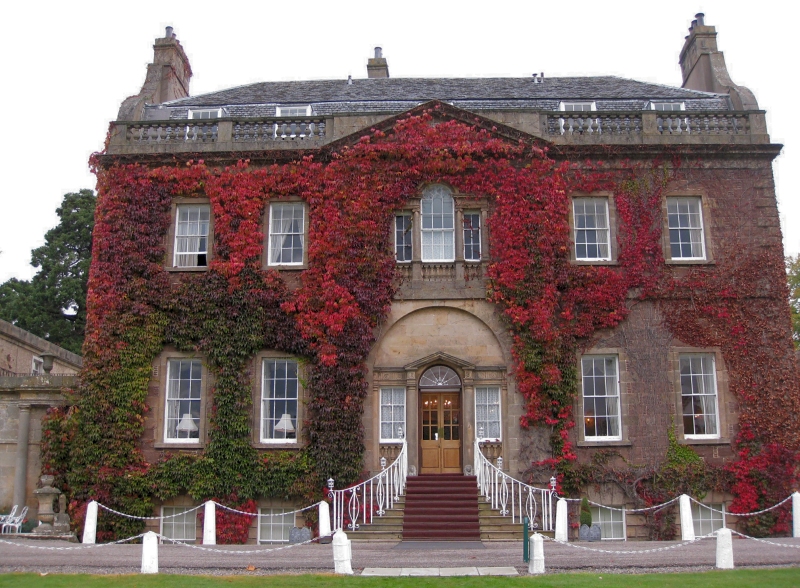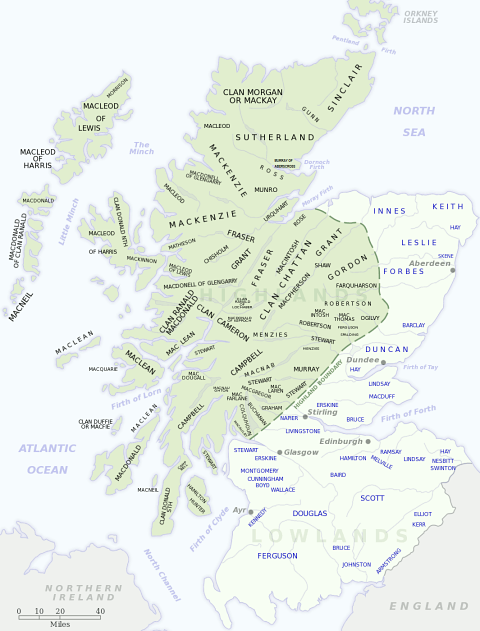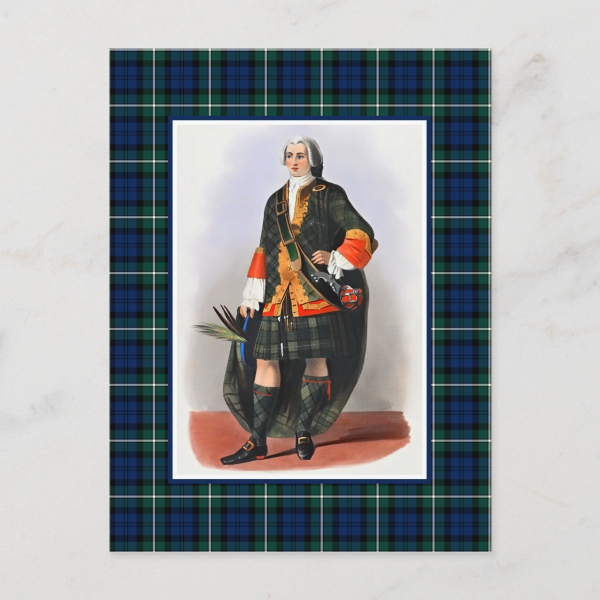
Motto: Grace, me guide
Historic Seat: Culloden House
District: Aberdeenshire
Associated Surnames: Berry, Boyes, Michie, Walters
Associated Tartans:
Early Forbes Genealogy and History:
(Excerpt from "The Scottish Clans and Their Tartans", James Grant, 1906)
Concerning the origin of this clan, John of Forbes, the first upon record, seems to have been a man of importance in the time of William the Lion, and was (says MacFarlane) the father of Fergus, from whom the clan are descended. His name appears in a charter of Alexander, Earl of Buchan, dated 1236. His son Alexander, a man of high valour, lost his life when defending the Castle Urquhart against Edward I, who, with his usual barbarity, put the entire garrison to the sword in 1303; but he left a son, also Alexander, who fell at the battle of Dupplin1 in 1332.
The posthumous son of the latter, Sir John Forbes of that Ilk, was a man of eminence in the days of Robert II and Robert III. He had four sons by Elizabeth Kennedy of Dunure, and from the three younger, sprang the Forbesses of Pitsligo, Culloden, Waterton, and Foveran. By Robert III he was made Justiciary of Aberdeenshire, and died in 1406.
His eldest son Sir Alexander of that Ilk, joined the constable Buchan in France at the head of 100 horse and 40 pikeman; and, after serving with honour in the war against Henry V, was raised ot the Peerage by James I as Baron Forbes about 1442. In 1426 he obtained bond of Manrent2 from Ogston of that Ilk, to attend him with three armed horsemen against all mortals, the King excepted. He married Elizabeth, daughter of the earl of Angus by the Princess Margaret, daughter of Robert III, and died in 1448, leaving two sons, James the Master of Forbes, and John, who became Provost of St Giles at Edinburgh.
James, second Lord Forbes, married a daughter of the first Earl Marischal, and had three sons - William, the third Lord, Duncan, ancestor of the Forbesses of Corsindae and Monymusk, and Patrick, ancestor of the Forbesses, Baronets of Craigievar, now Lord Sempill, and also of the Earls of Granard.
Alexander, fourth Lord Forbes, was in arms with his clan to revenge the murder of James III, but after the defeat at Tillymoss he submitted to James IV. John, sixth Lord, stood high in the favour of James V, from whom he got many charters. He had a feud with the citizens of Aberdeen, who withheld a sort of blackmail, a yearly tun of wine for the fishings of the Don. A fight ensued in 1526 in the streets. It lasted twenty-four hours, and many were slain. His descendant, Alexander, tenth Lord, was a General under Gustavus Adolphus3, and Colonel of Scottish Infantry in 1648, and is now represented by Horace, nineteenth Lord Forbes.
The Lords Pitsligo were descended from William, second son of Sir John Forbes of that Ilk, in the time of Robert II. Alexander, fourth Lord, was attainted after Culloden4, and living long secretly in one of his own gate lodges, died in 1762. Three families now claim the title.
The Forbesses, baronets of Craigievar, a branch of the old House, sprang from Patrick Forbes of Corse, armour-bearer to James III; and the Stuart-Forbesses of Pitsligo, Baronets, from Duncan of Corsindae, second son of James, second Lord Forbes. The Edinglassie Forbesses are also a branch of the parent stock.
The Forbesses of Tolquhoun, a very old branch, acquired that estate in 1420, and were progenitors of the Lairds of Culloden. Sir Alexander Forbes of Tolquhoun commanded a troop of cavalry in the Scots army at Worcester5; and when the King's horse was shot, mounted him on his own, put his buff coat and a bloody scarf about him, and saw him safe out of the field. The fortunes of this house were probably consumed in the fever of the Darien Scheme6 (like many other good old Scottish families), in which Alexander Forbes of Tolquhoun appears to have embarked beyond his means, the stock he held (£500) having been judicially attached.
Sir William Forbes, eighth Baronet of Craigievar, in 1884, succeeded his kinswoman as Lord Semphill.
(End excerpt)
Next page: Clan Fraser
Footnotes:
1 The Battle of Dupplin Moor (1332): The Battle of Dupplin Moor was fought 10-11 August, 1332, near Perth, Scotland between supporters of the infant David II, son of Robert the Bruce, and rebels supporting the Baliol claim to the throne. It was a significant battle of the Second War of Scottish Independence. Read more about the Battle of Dupplin Moor at Wikipedia.
2 Manrent: A Scottish contract of the mid-15th century to the early 17th century, usually military in nature and involving Scottish clans. The bond of manrent was commonly an instrument in which a weaker man or clan pledged to serve, in return for protection, a stronger lord or clan. Essentially, it was a promise by one person to serve another, such that he shall be friend to all his friends, and foe to all his foes. Read more about Manrents at Wikipedia.
3 Gustavus Adolphus: Gustav II Adolph, King of Sweden. Several Scottish brigades, who had been levied by King James VI, were under the military command of Sweden during the Thirty Years War. Read more about Scotland and the Thirty Years' War at Wikipedia.
4 The Battle of Culloden (1746): The Battle of Culloden was fought on 16 April 1746, on Drummossie Moor, near Culloden, east of Inverness Scotland, between Scottish forces led by Charles Edward Stuart (Bonnie Prince Charlie) and English forces led by William Augustus, Duke of Cumberland. It was the final confrontation of the Jacobite rising of 1745. Read more about the Battle of Culloden at Wikipedia.
5 The Battle of Worcester (1651): The Battle of Worcester was fought on 3 September 1651 at Worcester, England and was the final battle of the English Civil War. Cromwell's army defeated King Charles II's army, of whom the vast majority were Scottish. Read more about the Battle of Worcester at Wikipedia.
6 Darien Scheme: The Darien scheme was an unsuccessful attempt by the Kingdom of Scotland to become a world trading state by establishing a colony called "Caledonia" on the on the Gulf of Darién, Panama, in the late 1690s. Read more about the Darien Scheme at Wikipedia.

Distribution of Scottish clans and families
View larger map at Wikimedia Commons

Browse the Clan Forbes Tartan Collection with home decor, personal accessories, crafting, paper products, and more..

Browse the Clan Forbes Dress Tartan Collection with clothing, home decor, accessories, electronics cases, and more.

Clan Forbes Postcard: Digitally cleaned and enhanced vintage illustration with tartan border.